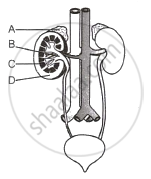Advertisements
Advertisements
Question
Give an example of androgens.
Solution
Testosterone is an example of androgen.
APPEARS IN
RELATED QUESTIONS
| Hormones | Target gland |
| Gonadotrophins (LH, FSH) | ______ |
Describe the T. S. of thyroid gland
In the table given below, fill in the blanks by naming endocrine glands, the hormones they secrete, and the function they perform, in a normal person.
| S.No. | Name of the gland | produced | Function |
| 1. | Thyroid | ||
| 2. | Insulin | ||
| 3. | Preparing the body for action | ||
| 4. | (i) Growth hormone (ii) Thyroid-stimulating hormone |
What is the difference between an exocrine gland and an endocrine gland?
Mention which of the statements are true (T) and which are false (F). Give reason in support of your answer.
Harmones ‘obey’ the commands like ‘enough, slow down or ‘two little, speed up’
Name the hormone responsible for the following function:
Increased reabsorption of water in the kidneys
Make a table indicating the glands, hormones produced, their main functions and diseases caused due to their hypo and hypersecretions.
What is a hormone?
Is the following gland an exocrine or an endocrine gland?
Liver
Give the Technical Term: Name the glands which secrete the following hormone: Testosterone
Fill in the Blanks:
______ is called father of endocrinology.
Fill in the Blanks:
Nervous system and ______ are very closely related.
Given below is an outline of the human body showing the important glands.

(i) Name the glands marked 1 to 5.
(ii) Name the hormone secreted by 2. Give one important function of this hormone.
(iii) Name the endocrine cells present in part 3.
(iv) Name the hormone secreted by part 3. Give one important function of this hormone.
Choose the Odd One Out
Which statement is not for a hormone?
In humans, the life processes are controlled and regulated by ____________.
Which of the following organs in mammals does not consist of a central meduallary’ region surrounded by a cortical region?
Given below is the figure showing the human urinary system with structures labelled A to D. Select the option which correctly identifies them and gives their function.

Distinguish between Diabetes mellitus and Diabetes insipidus (endocrine gland concerned).
Distinguish between the following pair:
Enzymes and hormones (mode of transport and target organ)
